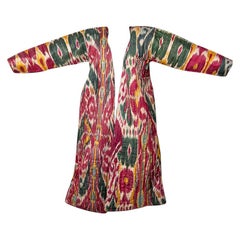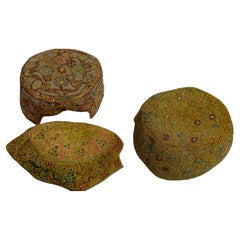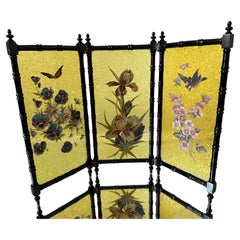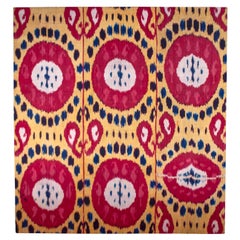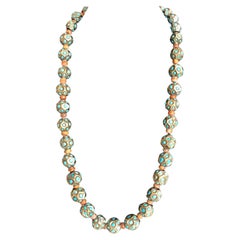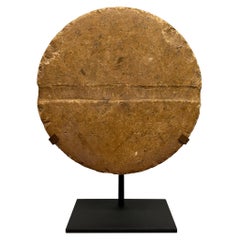Central Asian Antiquities
to
1
2
1
1
1
2
2
1
1
1
15,124
821
451
194
161
2
2
2
Place of Origin: Central Asian
Magnificent Silk Ikat Chapan, Uzbekistan, Xix Century
Located in San Pedro Garza Garcia, Nuevo Leon
Ikat Chapan – a man’s uzbek coat – Style Robe with exceptionally rich colour and dynamic pattering. Viewers may become lost in this ikat’s intertwining mot...
Category
19th Century Antique Central Asian Antiquities
Materials
Cotton
A collection of three embroidered Afghan hats
Located in Amsterdam, NL
Afghanistan, early 20th century
Provenance:
- Collection Rinck Hollnberger, Munich (purchased in the 1980s or 1990s)
Category
Early 20th Century Central Asian Antiquities
Materials
Cotton, Silk, Mirror
Related Items
Antique Swedish Hand-Painted Decorative Three-Panel Glass Screen
Located in Frederiksberg C, DK
Antique Swedish Hand-Painted Decorative Three-Panel Glass Screen
Exquisite antique Swedish hand-painted decorative three-panel screen. Crafted with finely carved and intricately det...
Category
Mid-20th Century Central Asian Antiquities
Materials
Glass, Wood
$1,654
H 19.69 in W 26.5 in D 0.75 in
Antique Central Asian Silk Ikat Panel, Uzbekistan
Located in Point Richmond, CA
Antique Central Asian Silk Ikat Panel, Uzbekistan
A large mounted silk and cotton ‘adras’ ikat panel with a dynamic 4-color design of large red rings with white centers surrounded b...
Category
Early 20th Century Tribal Central Asian Antiquities
Materials
Cotton, Silk
Swedish Stump Chair late 1700 century
Located in Farsta, SE
Exceptional Swedish Stump Chair ca 1650–1700
Crafted from driftwood sourced in Dalarna, Northern Sweden, this remarkable chair is made from a sing...
Category
1690s Folk Art Antique Central Asian Antiquities
Materials
Pine
Vintage Magician's Tool Collection - Assorted Magic Props and Accessories
Located in Mortsel, BE
Step into the world of classic magic with this unique collection of vintage magician's tools and props. This assorted set includes a variety of intriguing items, each with its own history and charm. From the traditional magician's hat and wand to more obscure tools, this collection is perfect for any magic enthusiast or collector. The items showcase the craftsmanship and creativity that were essential in the art of magic, making them not only functional but also fascinating pieces of history. Whether displayed as a complete set or used in performances, these vintage magic props...
Category
Early 19th Century Antique Central Asian Antiquities
Materials
Textile, Wood
$25,182
H 0.4 in W 0.4 in D 0.4 in
Milliners Hat Mold, Early 20th Century, USA
Located in Los Angeles, CA
Beautiful handcrafted milliners hat block made in the USA, early 20th century. Has been well used and as a result shows a perfectly aged, primitive patina. Gorgeous piece of milliner...
Category
Early 20th Century Primitive Central Asian Antiquities
Materials
Wood
Late 19th Century Silk Ikat Uzbekistan Tribal Weaving
Located in New York, NY
Gorgeous handwoven silk Ikat weaving in rich magenta, gold and purple color, circa late 19th-early 20th century, Uzbekistan, Central Asia, on the ancient...
Category
Late 19th Century Tribal Antique Central Asian Antiquities
Materials
Silk
19th Century Sycamore Bread Board
Located in High Point, NC
19th century bread board from England made from sycamore. The board is turned and has a molded edge. The border is hand carved with a wheat designs and has the word "Welcome" carve...
Category
19th Century Victorian Antique Central Asian Antiquities
Materials
Sycamore
20th Century Crow Decoy
Located in Coeur d'Alene, ID
Early 20th Century crow decoy. Carved and painted decoy on wood base. Glass eyes. Initials on bottom "AM."
Period: Early 20th century
Origin: United States
Size: 10"L x 14"H x 5"D
...
Category
20th Century Central Asian Antiquities
Materials
Wood
20th Century Crow Decoy
Located in Coeur d'Alene, ID
20th Century Crow decoy. Crow decoy mounted on modern base. Balsa wood, glass eyes. Life size, with base.
Period: 20th century
Origin: United States
Size: 16" x 4" x 12"H
Family O...
Category
20th Century Central Asian Antiquities
Materials
Wood
1960 Christian Dior Hat
By Christian Dior
Located in Mexico City, CDMX
We offer this rare 1960 Christian Dior hat, circa 1960.
Category
1960s Mid-Century Modern Vintage Central Asian Antiquities
Materials
Fabric
20th Century Sword Cane
Located in Coeur d'Alene, ID
Sword cane with carved mahogany curved handle, brass collar with push pull mechanism that reveals a two sided 17 1/2" blade and brass ferrule. 2 3/4" x 4", blade 17 1/2", overall 35"...
Category
20th Century Central Asian Antiquities
Materials
Mahogany
19th Century Coffee Grinder
Located in Louisville, KY
This well-preserved piece of American Coffee history is a site to behold. With it's ornately decorated iron grinder sitting atop an oak base joined with beautiful small dovetail jo...
Category
Late 19th Century Adirondack Antique Central Asian Antiquities
Materials
Wrought Iron
Previously Available Items
Rare Antique Central Asian Faceted Silver Gilt Turquoise Necklace Jewelry Gifts
Located in London, GB
A wonderful very rare Central Asian necklace of multi faceted silver and gold gilt beads with small turquoise pieces in each faceted section, beautiful antique beads dating from 17/1...
Category
Early 17th Century Antique Central Asian Antiquities
Materials
Gold, Silver
H 29.93 in W 0.6 in D 0.6 in
Bactrian Marble Disc Idol on Custom Mount
Located in Chicago, IL
A stunning hand-carved marble Bactrian Disc idol with linear grooves on both sides, mounted on a custom steel mount. Bactrian idols originate from North-...
Category
15th Century and Earlier Antique Central Asian Antiquities
Materials
Marble
Important Gold Fragment
Located in London, GB
This fragment forms part of the famed Ziwiye hoard of treasure, reputably found in 1947 in modern day Kurdistan. As the contents of a royal tomb of a great ancient king, the pieces were quickly dispersed and only in the following years did the huge significance become understood in scholarship. These objects have become famous as the keystone in explaining underpinning socio-economic and political cultural ties across the silk route, reflected by these works of art. These objects exhibit styles and motifs associated with the four pre-eminent cultures at this juncture in history: Assyrian, Scythian, proto-Achaemenid and the provincial native pieces. The Scythians, a seminomadic people from the Eurasian steppes who moved out from Southern Russia into the territory between the Don and the Danube and then into Mesopotamia are responsible for the basis of an ‘animal style’ design found on the elaborate metalwork and jewellery produced in Central Asian ancient world. This style starts to appear in the 7th century B.C typically on pierced plaques made of gold and silver, which depict running or fighting animals (reindeer, lions, tigers, horses) alone or in pairs facing each other, embossed with powerful plasticity and free interpretation of the forms. The animal- style had a strong influence in western Asia during the 7th century B.C. Such ornaments as necklaces, bracelets, pectorals, diadems, and earrings making up the Ziwiye treasure (discovered in Iran near the border between Kurdistan and Azerbaijan) provide evidence of this Asiatic phase of Scythian gold...
Category
15th Century and Earlier Antique Central Asian Antiquities
Materials
Gold
Sino-Siberian Dagger
Located in London, GB
The nomadic nature of the Eurasian steppe tribes allowed for much integration and exchange of styles and customs, as well as physical transportable objects; including personal ornamentation and weaponry. Particularly between the Scythian tribes of the Black sea region in the West, Central Asian tribes such as the Hephthalites, the Wushu, Yuezhi and Mongolians to the East and the Persians further South. The blade of this piece has strong ties to daggers of the late Chinese Shang...
Category
15th Century and Earlier Antique Central Asian Antiquities
Materials
Bronze
The 'George Sand' Bull
Located in London, GB
The Amlash culture is known almost exclusively through the archaeological record that has come to light in recent decades. The term refers to the material culture found in the modern...
Category
15th Century and Earlier Antique Central Asian Antiquities
Materials
Terracotta
'Damon' Candlestick
Located in London, GB
Resting on a wide, trumpeted foot, this wonderful candlestick rises from a band of chased keyfret motif to a body of open pierced fretwork, which consists of thuluth calligraphy agai...
Category
15th Century and Earlier Antique Central Asian Antiquities
Materials
Copper
Minai Ceramic Jug
Located in London, GB
A polychrome Minai (enamel) handled cup from the latter half of the Turco-Persian Seljuq period (1040 - 1307), most probably from Kashan, a significant centre of ceramics production during this time where potters moulded, fired and painted both Minai and lusterware works. This handled cup rises from a short foot and widens to a spherical body, which tapers towards its neck at its widest point, emphasizing its curvature, and flares slightly at its rim. The artist has painted figures upon horseback, rendered in vibrant colours and outlined in black and gold, on the central frieze that encircles the body. Above the figures runs a blue band of Arabic calligraphy, written in Kufic script, while on the same spot in the interior of the cup there is a band of orange calligraphy, executed again in the Kufic style. The handle is S-shaped with a delicate, pale green scrolling pattern, which couples to underscore its function as a drinking utensil, along with its opulence; a luxurious example of the material culture of pre-Mongol Iran. Minai means enamel in Persian, and the term refers to this type of pottery’s colourful decoration, which lies both in and over the glaze, here further enriched with gold (gilding) which is visible on the horse’s reigns and the bows on their tails. Only certain colours are fixed as over glazed enamels. Some, such as turquoise, blue and purple are normally painted into the opaque white glaze after it has been applied and are fixed with it in the firing. Enamel pigments are then painted, and fixed in the second firing. These are normally restricted to red and black, but in more ambitious pieces, such as in this case, a whole range of other enamel colours are found together with gold gilding. Such Minai works had to be fired twice in order to achieve their polychromatic harmonies and were consequently the most sought-after and costly wares; we can thereby infer that the patron or owner was likely to have been a member of the Seljuq elite. The Seljuqs descended from nomads (specifically the Turkic Oghuz clan) who grazed cattle on the Central Asian land that the previous Persian dynasty...
Category
15th Century and Earlier Antique Central Asian Antiquities
Materials
Ceramic
Kashan Lustre Vase
Located in London, GB
It has long been conjectured, though there is no proof, that at the end of the twelfth century a group of Egyptian potters fled the rapidly declining Fatimid caliphate and settled in...
Category
15th Century and Earlier Antique Central Asian Antiquities
Materials
Ceramic
Fragment of a Scabbard Terminal
Located in London, GB
Taken from a larger gypsum wall carving, this triangular fragment displays the hilt and scabbard of a dagger or ‘akinakes’. Decorated with a pair of outward facing rampant lions, eac...
Category
15th Century and Earlier Antique Central Asian Antiquities
Materials
Stone
Antique 19th Century Hand Carved Afghan Chief's Chair with Stool
Located in Peabody, MA
A mid to late 19th century Afghan armchair and stool, back panel ornamented with chip carving of tribal designs. Fashioned of Himalayan cedar and goat-hide and pegged together withou...
Category
19th Century Tribal Antique Central Asian Antiquities
Materials
Hide, Cedar
Recently Viewed
View AllMore Ways To Browse
Foot Bath
Frank Lloyd Wright Vase
Franz Pottery
French Lingerie Chest
French Terra Cotta Statues
French Vaisselier
Gear Wheel
George 1 Chest Of Drawers
Giacometti Style Statues
Ginbari Vase
Gold Screen Crane
Grand Tour Neoclassic Statues
Greek Krater
Green Glass Elephant
Green Wedgwood Vase
Haddon Hall Furniture
Hand Blown Glass Horses
Haring Pottery
